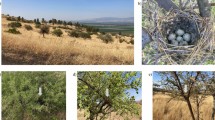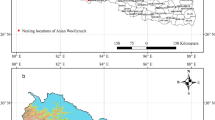Abstract
Colonial nesting of long-legged wading birds (Ciconiiformes) in the coastal northeastern U.S. is limited primarily to islands, which provide isolated habitats that are relatively free of ground predators. Estuarine wetlands in this heavily developed region, including foraging wetlands and fringe marshes surrounding nesting islands, are often dominated byPhragmites australis. On Pea Patch Island in Delaware Bay, site of one of the largest and most enduring mixed-species heron colonies on the East Coast, wading birds nest inPhragmites marsh habitat as well as in adjacent upland shrubs and trees. BecausePhragmites is aggressively managed in Delaware Bay, we investigated the relative habitat value of marsh and upland nesting sites for the purpose of developing recommendations for marsh and wildlife management. Utilization of marsh habitat by nesting birds ranged from 27–82% during 1993–1998. Two species (great blue heronArdea herodias and great egretA. alba) never nested inPhragmites, four species (little blue heronEgretta caerulea, snowy egretE. thula, cattle egretBubulcus ibis, and black-crowned night-heronNycticorax nycticorax) nested in approximately equal proportions in both habitats, and one species (glossy ibisPlegadis falcinellus) was largely confined to marsh nesting. Productivity (egg and nestling production) varied between habitats for some species. Cattle egrets produced larger clutches and had higher hatching rates inPhragmites compared to upland habitat. Little blue herons were more successful in the uplands. Managers should retainPhragmites marsh at colony sites, such as Pea Patch Island, where it provides critical habitat for nesting wading birds both as substrate for nesting and buffer habitat to control human disturbance.
Similar content being viewed by others
Literature Cited
Beaver, D. L., R. G. Osborn, andT. W. Custer. 1980. Nest site and colony characteristics of wading birds in selected Atlantic coast colonies.Wilson Bulletin 92:200–220.
Burger, J. 1981. A model for the evolution of mixed-species colonies of Ciconiiformes.Quarterly Review of Biology 56:143–167.
Cutler, D. A. 1964. Middle Atlantic coastal region.Audubon Field Notes 18:500–502.
Delaware Estuary Program. 1996. Comprehensive conservation and management plan for the Delaware estuary. U.S. Environmental Protection Agency National Estuary Program. Washington, D.C.
Erwin, R. M. andC. E. Korschgen. 1979. Coastal waterbird colonies: Maine to Virginia, 1977. FWS/OBS-79/08. U.S. Fish and Wildlife Service, Office of Biological Services, Washington, D.C.
Moser, M. E. 1984. Resource partitioning in colonial herons, with particular reference to the grey heronArdea cinerea L. and the purple heronArdea purpurea L., in the Camargue, S. France. Ph.D. Dissertation, University of Durham, Durham, U.K.
Parnell, J. F., W. W. Golder, M. A. Shelds, T. A. Quay, andT. M. Henson. 1997. Changes in nesting populations of colonial waterbirds in coastal North Carolina, 1990–1995.Colonial Waterbirds 20:458–469.
Parsons, K. C. 1995. Heron nesting at Pea Patch Island, upper Delaware Bay, USA: Abundance and reproductive success.Colonial Waterbirds 18:69–78.
Parsons, K. C., A. C. Matz, M. J. Hooper, andM. A. Pokras. 2000. Monitoring wading bird exposure to agricultural chemicals using serum cholinesterase activity.Environmental Toxicology and Chemistry 19:1317–1323.
Parsons, K. C., S. R. Schmidt, andA. C. Matz. 2001. Regional patterns of wading bird productivity in northeastern U.S. estuaries.Waterbirds 24:323–330.
Pea Patch Island Heronry Region Special Area Management Plant. 1998. Pea Patch Island heronry region: Special area management plan. Delaware Department of Natural Resources, Dover, Delaware.
Telfair, R. C. 1994. Cattle Egret (Bubulcus ibis), p. 1–32.In A. Poole, and F. Gill (eds.), The Birds of North America. No. 113. The Academy of Natural Sciences, Philadelphia, Pennsylvania and The American Ornithologists' Union, Washington, D.C.
Wiese, J. H. 1978. Heron nest-site selection and its ecological effects, p. 27–34.In A. Sprunt, J. C. Ogden, and S. Winckler (eds.), Wading Birds. Research Report 7. National Audubon Society, New York.
Wiese, J. H. 1979. A study of the reproductive biology of herons, egrets and ibis nesting on Pea Patch Island, Delaware. Delmarva Power and Light Company, Wilmington, Delaware.
Source of Unpublished Materials
Delaware Department of Natural Resources and Environmental Control. Unpublished data. 89 Kings Highway, Dover, Delaware 19901.
Author information
Authors and Affiliations
Corresponding author
Rights and permissions
About this article
Cite this article
Parsons, K.C. Reproductive success of wading birds usingPhragmites marsh and upland nesting habitats. Estuaries 26, 596–601 (2003). https://doi.org/10.1007/BF02823734
Received:
Revised:
Accepted:
Issue Date:
DOI: https://doi.org/10.1007/BF02823734




